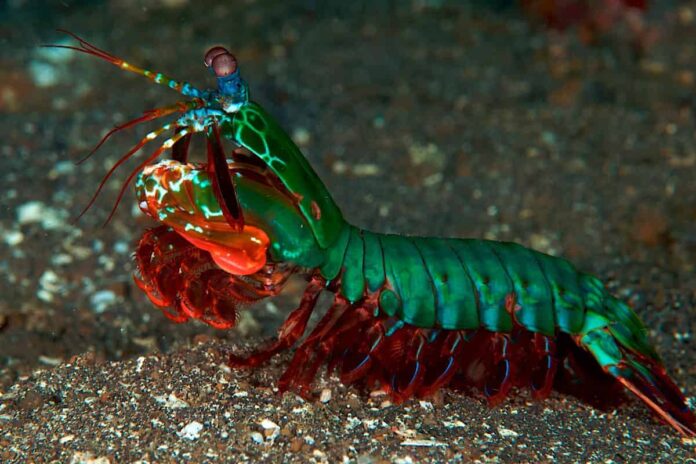One of the most unusual creatures in nature on our planet, the mantis shrimp, inhabits the western part of the Pacific Ocean, in tropical seas up to the Sea of Japan. Dangerous and aggressive, it possesses the beauty and coloring of a peacock’s tail. Once you see this creature, you won’t mistake it for anything else. In this article, we’ll explore interesting facts about the mantis shrimp to help understand this unique creation of nature.
Description and Species
This creature could easily be mistaken for an extraterrestrial, despite its small size. The mantis shrimp measures 10-30 cm in length and can weigh up to 200 grams. Its entire body is covered with a chitinous armor similar to that of crustaceans. It has five pairs of limbs and digs burrows where it lives. It belongs to the class Stomatopoda.
There are 2 species of mantis shrimp. The first species has a very inconspicuous coloration to facilitate hunting. It buries itself in the sand at the bottom, and when prey swims by, it springs out and grabs it with lightning speed. The grip is so strong that the victim has virtually no chance of escaping.
The second species is brightly colored, signaling lethal danger. It can attack its prey with its limbs at bullet speed and impact force. Few organic creatures can withstand such a blow. The claw of the attacking mantis shrimp moves at a speed of 70-80 km/h, which is a record among animals.
Upon impact, bubbles form at the point of attack, with temperatures comparable to the surface of the sun! These bubbles are formed due to the so-called cavitation, where the water heats up so much after the impact that it simply begins to evaporate. This releases gas that rushes to the surface. The bubble then immediately collapses, creating a powerful shock wave that further stuns the prey.
The secret of such striking force lies in the special structure of the mantis shrimp’s limbs and muscles. This creature can contract a muscle and hold it in such a state, called a latch. At the moment of impact, the latch opens, releasing the muscle, which rapidly straightens with additional kinetic acceleration. This action most closely resembles a crossbow shot.
The high content of the mineral hydroxyapatite, also found in the human body, gives the limbs of the mantis shrimp additional strength.
Mantis Shrimp Vision: The Predator’s All-Seeing Eye
The eyes of the mantis shrimp are unique. While humans have only 2 photoreceptors – rods and cones, these underwater inhabitants have sixteen. Additionally, they can see in infrared radiation (remember the Predator’s vision?) and ultraviolet. But that’s not all – their eyes can also distinguish circular and linear polarization.
Mantis shrimp can see in multiple planes simultaneously, with each of their eyes moving independently of the other. We can’t even imagine what that’s like, as we only see in one plane.
Thus, these animals possess the most complex visual system ever studied. The scientific world is yet to understand the purpose of such incredible vision for this small creature.
Can You Keep a Mantis Shrimp in an Aquarium?
It would be difficult because the strike of this stomatopod’s claw can easily pierce the aquarium wall. You can keep either very young specimens, or you’ll need to acquire a specially reinforced aquarium. Also, keep in mind that this predator will destroy all the other creatures in the aquarium.
Who created it like this and for what purpose remains unknown. Perhaps it came to us from another planet? Or is it the result of some monstrous experiment? There is much unknown and incredible in the world.
